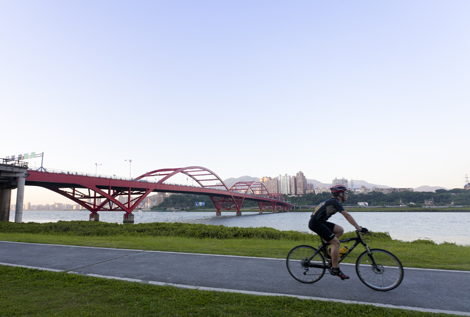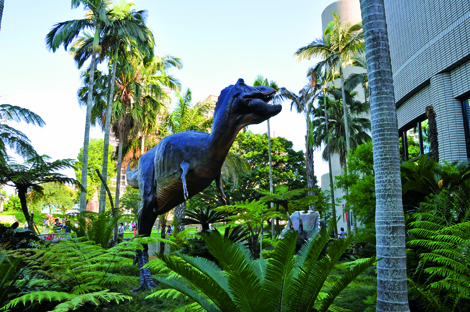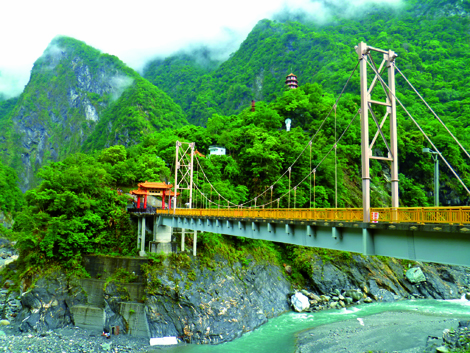
Craig Ferguson gets on his bike and explores Taipei’s hinterland courtesy of 200km of dedicated cycle paths along its rivers

Bali Left Bank
A five-minute ferry ride from Danshui is the town of Bali where cycling is the main attraction. Keeping the river to your right the path winds through the Waziwei Nature Conservation Area, mangroves and an old fishing village before ending up at the Shisanhang Archaeological Museum. The museum focuses on the Shisanhang people who settled the area 1,800 years ago, and displays artefacts unearthed during the mid-20th century. Retrace your route, continue past the ferry wharf and follow the bike path along the riverside park until you reach Guandu Bridge. There’s a café there for some refreshment if needed, otherwise keep riding under the bridge. As the path starts to curve around to the right, you’ll be rewarded with sweeping views of Taipei city across the wide Danshui River.
Guandu and the Golden Riverside
On the opposite side of the river is Guandu and the Golden Riverside bikeway. Bike rental is available either outside Guandu MRT station or down by the riverside path itself. Spend some time exploring the Guandu Temple, the oldest Mazu temple in Taiwan, before getting on your bike and following the path towards the Guandu Nature Park. This park is a haven for migratory birds in the cooler months, as well as being home to fiddler crabs and local water birds. The route is flanked by mangroves and the river, with a couple of refreshment stops along the way. Turn around and return towards Guandu and keep going past the temple, making your way toward Danshui along the Golden Riverside. The fine views across the river of Mount Guanyin and the dense mangrove forest make this a very scenic ride. At Hongshulin MRT you’ll find the Mangrove Education Center if you want to learn more about the area. A couple of kilometres farther is Danshui, where you can eat some fresh seafood, shop in the night market or take in the sunset at Fisherman’s Wharf.
Keelung Riverside
On either side of the Keelung River lie bike paths just over 20km long, the southern side being slightly longer. This is a great ride for an afternoon or evening. The cycleways here head through large riverside parks with facilities for baseball, soccer, tennis and other sports scattered throughout. The western end of the Keelung bikeway is by the Grand Hotel, with the nearby Martyr’s Shrine worth a detour to see the changing of the guard. Heading east, you approach Dazhi Bridge where dragon boat races are held during the midsummer festival. As you approach the eastern end, you’ll see Rainbow Bridge, a pedestrian bridge that is a favourite spot for photos due to its distinctive arched shape. You can cross this with a bike although riding is not allowed. Follow a short lane on the southern bank and you’ll find yourself in Raohe Street night market, where a range of delicious snacks await.
Jingmei River
The Jingmei River bike path has only recently been completed,
with the final stretch finished in March 2011. The completion means that all of Taipei city’s bike paths are now fully connected. This path takes you from outside Taipei Zoo where you can rent a bike, past playing fields and universities, and eventually meets up with the Xindian River and then Danshui River. Along the way you’ll pass
the Treasure Hill Artists Village, the historic centre of Dadaocheng with its old temples and spice markets, and numerous riverside parks.
Luzhou-Sanchong
Bordered by the Danshui River on one side and the Shuhong Floodway on the other, the Luzhou-Sanchong bikeway is basically a loop. From the southern end follow the Shuhong floodway north, passing a large lotus park, playing fields, flower gardens, and as you approach the northern end, some wetlands that make you feel as if you’ve left the city far behind. Head back down the eastern side of the loop, skirting the Danshui River with great views of Yangmingshan across the water and small market gardens next to the path.
Increasing the challenge
If you’re after more of a challenge, Taiwan has some fantastic mountain rides and longer routes. In Taipei itself, Yangmingshan has numerous routes popular with local cycling enthusiasts. Start from outside the National Palace Museum in Shilin and follow Zhishan Road up and over the mountains. Numerous options are available here, including continuing all the way over Yangmingshan and down to Jinshan on the north coast, from where you can follow the mostly flat coastal highway all the way west to Danshui.
For a real workout in the north, try tackling the Bailaka Highway. Starting near Hongshulin MRT station, this follows the 101 road up the northwest side of Yangmingshan to Mount Datun. This route has the same profile as the famed Tour de France mountain Alpe d’Huez.
Where time permits, it’s worth getting out of Taipei and heading over to the east coast. One of the most beautiful routes in Taiwan stretches south from Hualien along Highway 11, which runs along the coast all the way to Taitung. It’s about 170km but is mostly flat. If you spend two or three days riding it slowly it’s easy to complete, even for novice riders.
Bike rental
Giant Bicycles have a rental system where you can pick up a bike at one location and return it at another. This is only available from certain stores and costs from NT$250–$500 (US$8.50-$17) per day depending on the type of bike required. This is a perfect option for longer rides.
Around Taipei there are a lot of government-sponsored rental stores near the bike paths that let you rent from one location and return at another. Look for the Taipei Cycling map at MRT stations and tourist information counters to find your closest rental centre. Around Taipei, prices start from NT$20 (US$0.70) per hour up to NT$350 (US$12) per day.
Delia Yin tours the green city of Taichung, Taiwan’s youngest direct-controlled municipality

National Museum of Natural Science
This is Taiwan’s first museum to focus on natural sciences, with six main areas: a Space Theatre, Science Centre, Life Science Gallery, Global Environment Gallery, Human Cultures Gallery and Botanical Garden. Permanent exhibitions encompass the fields of astronomy, physics, earth science, palaeontology, zoology, botany and anthropology, and there are also special showcases. It would take a long time to cover the whole museum but the clear divisions mean visitors can easily focus on what’s of most interest to them. I was impressed by the dinosaur exhibition in the Life Science Gallery, where realistic robot beasts terrified and excited the child in me.
The newly opened themed exhibition “World of Semiconductors” is also worth a view, especially as you are in Taiwan, which thrives on manufacturing electronics products. The museum has been open for 25 years but all the facilities and galleries are modern. The museum also has its own botanical garden featuring many indigenous plants; the entrance fee for the garden is NT$20 (US$0.7).
Open Tue-Sun 9am-5pm, tickets cost NT$100 (US$3.5), free admission on Wednesday 9am-10am; 1 Guancian Road, tel +886 4 2322 6940, www.nmns.edu.tw
Green Parks and Art Garden
Taichung’s National Taiwan Museum of Fine Arts is an elegant building and it is pleasantly surrounded by a large green area and a public square dotted with unique sculptures. Exit the museum to walk along Wu Chuan West Road and you will find the Art Garden. On both sides of the road are idiosyncratic restaurants that serve everything from Chinese, French and Italian to Japanese and Middle Eastern cuisine. Some are even themed, with creative concepts such as fairytales.
These museums and green spaces are all part of Calligraphy Greenway (www.calligraphy-greenway.com.tw), a tourism project actively developed by the Taichung government. The concept is cursive writing, representing the lines and shapes that inspired the area’s layout.
On one end of this urban greenbelt is the Eslite Bookstore, which features a large vertical garden on its exterior, consisting of 15,000 plants. Of course, the inside is equally appealing, with an emporium of books and souvenirs to explore.
Open Tue-Fri 9am-5pm, until 6pm on weekends; free admission except special exhibitions; 2 Wu Chuan West Road, Section 1, tel +886 4 2372 3552, www.ntmofa.gov.tw
Stock 20
It’s hard to imagine that at the back of a railway station there might be an art village. Taichung Station is almost a century old and it is still in use, but a decade ago the abandoned warehouses behind it were designated as part of a project called Taichung Railway Art Village. Starting from Number 20, seven warehouses with a total area – both indoor and outdoor – of 4,200 sqm became home to theatres, artist workshops and exhibition spaces. Regular art seminars are also held here.
I arrived here through the underground walkway that exits from the rear of Taichung Station, where I immediately spotted a sign pointing to Stock 20. The main exhibition area was showing three-dimensional pieces made from metal wires. The row of warehouses stretches all the way to Number 26, and farther down there are old black train carts that now serve as venues for interactive art classes.
Open Tue-Sun 11am-8pm, free admission; www.stock20.com.tw
Jin Ming 1st Street and Da Long Road
The vibrant business area of Jin Ming 1st Street in the centre of Taichung city is famous for its many unique shops selling gifts and novelties, art works and fashion, as well as restaurants of all sorts scattered around the numerous lanes and alleyways. There is also an area of outdoor coffee shops. Some merchants here might even tell you that this is Taichung’s own Champs-Elysées. Maybe it doesn’t quite live up to that standard, but it is definitely a nice place to hang out with friends over snacks and coffee.
Connected to Jin Ming on one end is Da Long Road, which features a pedestrianised zone. It is a long thoroughfare but most of the shops are concentrated in the section between Jing Cheng Road and Dong Xing Road. There are 50 retailers on this 300-metre stretch, many of them offering hip and trendy merchandise.
Feng Jia Night Market
This is Taichung’s biggest night market, located between Feng Jia Road, Wenhua Road and Fu Xing Road. All the streets and lanes are full of hawkers selling tasty snacks of all shapes and sizes, laid out under the colourful signs and stalls. I tried a big chunk of pig’s blood cake covered in peanut flakes, which has topped VirtualTourist.com’s list of 10 strangest foods in the world. It was actually very tender and had a unique flavour. I washed it down with a soymilk tea, which is a famous drink in the central and southern parts of Taiwan. It was delicious.
Feng Jia Night Market is not just about food, as there are also plenty of trendy shops – so many, in fact, they made me dizzy. It gets really packed here in the evening, and when it is a holiday and the weather is nice, you can have up to 100,000 visitors here at any given time. Business is so good that the locals told me that as every month passes there seem to be more and more new shops opening. This is where you get to see the latest and the newest of local culture, and it makes for a great night out.
Jenny Southan explores the gorges and trails of Taiwan’s aboriginal wilderness

Emerging from a long, dark tunnel that cuts through the rock of the Chingshui Cliffs in Eastern Taiwan, the Suhua Highway reveals steep mountainside thick with vegetation and, down below, the brilliant turquoise of the Pacific Ocean.
Until 1980s, when the road between Su-ao and Taroko was widened to allow two-way traffic, this stretch was one of the most dangerous in the world because of the sheer drops and threat of landslides. That said, it can still be hazardous for lorry drivers, who will end up wedged beneath overhanging rock if they calculate the height of their vehicle incorrectly.
The journey to Taroko National Park – which, at 92,000 hectares, is more of a wilderness than anything – takes about four and a half hours by car from Taipei. You can fly from the capital to nearby Hualien airport in 40 minutes but if you go across land, you can take in the dramatic scenery and stop for a bite to eat – there is some fantastic cuisine to enjoy in this part of the world. I stop at Dageeli restaurant (tel +886 3862 1033) and eat in the rain beneath the trees (Taiwan has a subtropical climate – hot and sticky in the summer with downpours throughout the year).
The eatery is run by Taiwanese aborigines and there is no menu, so once you have let them know of any dietary requirements they will present you with an alfresco feast. This may include young papaya, pink roselle flowers in syrup, bitter gourd stuffed with fish paste, glutinous rice in banana leaves, and ferns sprinkled with dried baby fish – all perfect with a nice cup of green tea.
Lunch over, and a short drive later, I come to the Bridge of 100 Lions, a vibrant red arc studded with white stone statues that spans the Shakadang stream. I descend steep steps to one of the park’s many hiking trails and trek for several kilometres alongside hand-carved marble rockfaces, with sapphire blue pools beneath me.
The climate isn’t always ideal for trekking – the Liwu River rises so high during monsoons that it floods the roads – so be aware when planning a trip (trail closures are listed on www.taroko.gov.tw). Still, retreating afterwards to the Silks Place hotel (http://taroko.silksplace.com.tw), nestled in the heart of Taroko Gorge, will be a luxurious and calming reward whatever the weather.
After several hours of engagement with nature, I embrace check-in at this Zen-like property with open arms, stripping off boots and mac as soon as I get to my room and running a bath. Silks Place offers elegant rooms (from NT$4,069/US137 in July) with river or mountain views, plus a spa, pool and a gourmet restaurant serving authentic Chinese cuisine. It can also arrange guided tours of nearby trails, as well as day trips to Houhan Mountain (NT$1,400/US$47).
The next morning, I meet my guide and head down the snaking road to the Tunnel of Nine Turns, which was hollowed out in the mid-1990s so visitors could pass through the side of the vertiginous cliff and view the rushing water far below. Since relations have improved between mainland China and Taiwan, the island has seen an increase in tourists and the gorge is a big draw, so expect to compete for photo opportunities with large groups of Chinese people.
In search of something a little more spiritual, I seek out the Eternal Spring Shrine, a short drive downriver – while the tours usually make a quick stop here, more intrepid explorers can make it the starting point for a mountain hike that promises a magnificent vista. The paths are well constructed but arachnophobes beware – a
few glances at the exotic foliage all around reveal huge webs with poisonous-looking spiders at their centres.
Arriving at the top after a good 40 minutes negotiating hairpin bends and a lot of steps, my reward is a virtual bird’s-eye view of Taiwan’s cloud-clad peaks, and a small shrine of red, green, white and blue lacquer. It couldn’t be further from the brash neon of Taipei, and when I find a solitary bell inside the monument, I pull the rope and ring it, listening to it echo through the jungle valley.
Visit www.taiwantourism.org








